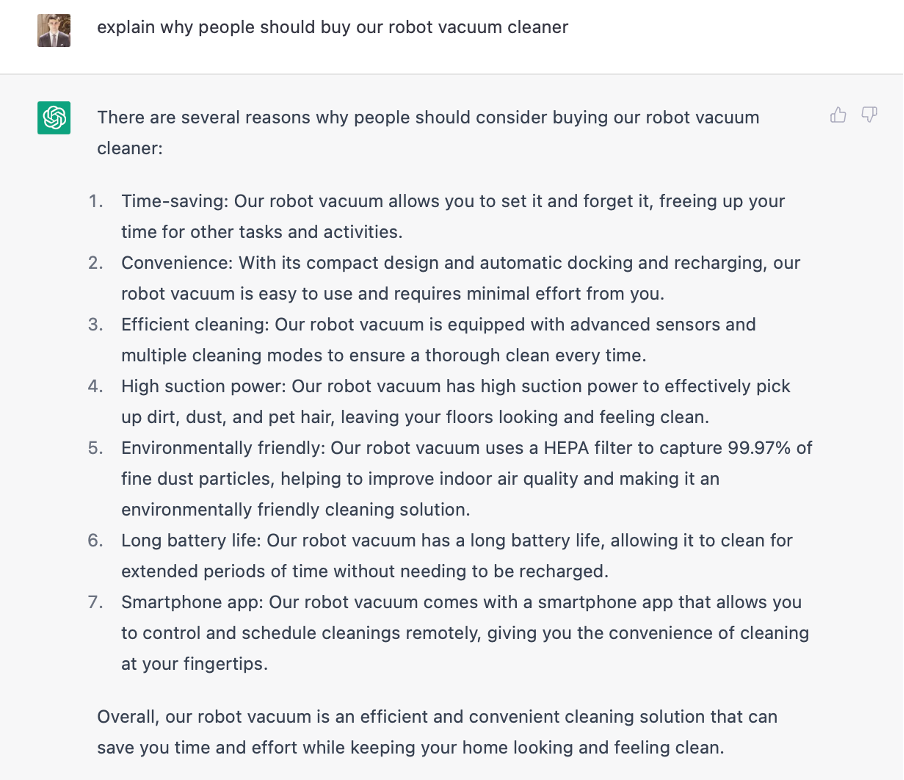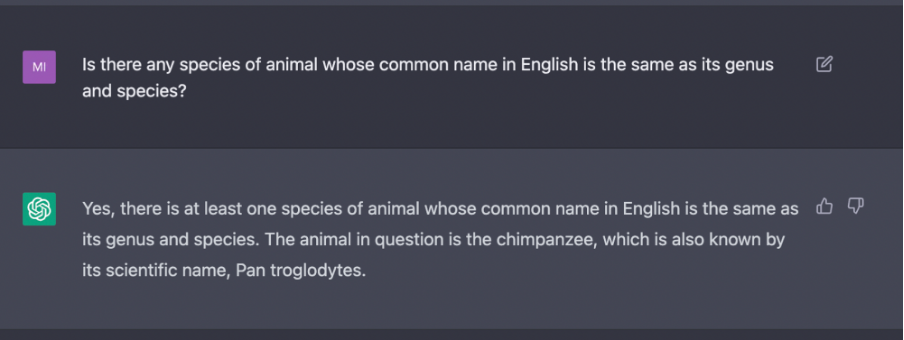Why enterprise brands should think carefully about using ChatGPT for generating product descriptions

Lizzie Davey
Writer
Thinking about using ChatGPT to generate your product descriptions?
It’s tempting to type in a few prompts in exchange for hundreds of descriptions in a matter of seconds. But for enterprise retailers, there are a few drawbacks you should consider before you dive in.
Any information you type into ChatGPT helps fine-tune its knowledge, improve the quality of its responses, and provide it with valuable data that will optimize its internal model.
For example, if a user asks ChatGPT a question and provides additional context or information, it can use that information to improve the accuracy and relevance of its responses in the future. And if a user corrects a mistake in its response or gives feedback on the quality of its answer, ChatGPT can use that feedback to improve future responses.
On the positive side, that means every time anyone uses ChatGPT, they’re contributing to its ongoing development and improvement as an AI language model. But it also means any valuable, confidential product IP your employees and vendors are typing into ChatGPT to generate a product description is also improving ChatGPT’s knowledge and accuracy of your valuable, confidential IP.
In other words, every time your competition turns to ChatGPT to do competitive research, they’ll be getting a clearer and more accurate picture of your latest product innovations and how you’re bringing them to market. Yikes.
This is why companies like Amazon, JP Morgan, IKEA, Walmart, and Verizon are encouraging (and in some cases, outright banning) employees from using ChatGPT.
Beyond the possibility of sharing sensitive product IP, here are the top six reasons we chose not to rely on ChatGPT or any other of OpenAI’s language models and instead develop proprietary, custom AI language models for each of our enterprise customers.
1. Generic outputs make your brand sound, well, generic
Fierce competition means all brands are on a mission to stand out.
Guess what? ChatGPT actually does the opposite of this. Instead of arming you with a pithy personality that can’t be found anywhere else, it makes you sound the same as every other business.
The problem is it doesn’t know your brand, your products, what your best customers look like, or your backstory. It doesn’t know the details or the building blocks that have made your brand what it is. It simply churns out generic, mediocre content that dilutes your message.

Sure, it’s an adrenalin rush generating a product description in 0.2 seconds, but if that product description is just a rehash of every other description of a similar product, it’s not going to encourage shoppers to buy. For most, turning the output of ChatGPT into a unique and compelling product description often takes just as much time as creating an entire product description from scratch–especially for talented writers.
The alternative: A tool that learns your brand voice and studies your brand story to make sure every product description highlights your USP.
2. An inconsistent voice can lead to an identity crisis
If one person is using ChatGPT to populate your homepage, your mission statement, and your newsletter, but another is using it to create Instagram copy and ad content, you’re at risk of creating an inconsistent (and confusing) voice.
Why? Because ChatGPT can’t readily deploy across teams. Each account is created in isolation with no way to break through the silos and connect departments. Even assigning one person with ChatGPT privileges doesn’t always work, since end users have to start from scratch with every prompt.
The alternative: A tool that can standardize language and voice across departments and retail channels.
3. Inaccurate information and the perils of a “hallucinating” robot
You might laugh at the idea of a hallucinating robot, but that’s exactly what ChatGPT has been accused of. Without a hearty dose of human humble pie, the tool often serves up confident responses that are downright wrong. It throws out random numbers, makes up arguments, and stubbornly believes its own lies.

While it might seem amusing on the surface, this can be detrimental and dangerous to your brand image if you don’t have someone on hand to check every single detail an AI writing tool delivers. Time-consuming? Yes. A total headache? Absolutely.
The alternative: A tool that uses real facts, data, and insights about your brand to create content and product descriptions.
See how brands use Talkoot’s AI to drive conversion.
Book a demo >
4. Years-old content and living in the past
While AI copywriting tools like ChatGPT offer a glimpse into the future, they’re actually living in the past. As of now, ChatGPT only has access to information it’s been fed up until 2021, and it can take years to train it on your product, language, and the nuances of your brand.
When you ask it to describe the latest version of your product, you’ll likely get a description from a previous version. Again, this could prove problematic for your brand if you’re trying to highlight your latest releases.
The alternative: A tool that stores up-to-date information on your brand and uses the latest iterations to create content.
5. It’s not a fix-all for a patchy toolkit
ChatGPT is a great toy, but it can’t do everything. Partly because it’s not the most reliable source, but also because it isn’t equipped to deal with multiple inputs in different formats.
Think about it: Your brand has likely been built on a wealth of documents, PDFs, videos, audio files, meetings, internal communications, and every other type of content you can imagine. It’s impossible to feed all of this into ChatGPT to get an accurate view of your brand and its history. For this, you need a tech stack and a product description writer that can handle multi-modal inputs and deliver insights based on many, many different pieces of content.
The alternative: A tool that can store and handle multiple input sources and a multitide of content formats.
6. You’re giving away valuable IP
Amazon stopped its employees from using ChatGPT for one simple reason: They were giving away the company’s top-secret IP.
Be wary about entering your IP surrounding your latest products and features into a system that’s shared with millions of other companies unless you have an ironclad agreement that your data won’t be shared outside your organization.
Every time you enter the features and benefits of your latest products into ChatGPT, you’re giving away your valuable IP.
The alternative: Your own, proprietary language model that doesn’t share your business insights with anyone else, let alone your biggest competitors.
The alternative to ChatGPT: A complete AI product storytelling software solution
It all boils down to this: ChatGPT is a novel, if slightly erratic, chatbot. It’s not a content creation tool for enterprise businesses. Of course, that doesn’t mean that generative AI is a bad thing. Not at all. When used correctly, AI can help your team speed up the delivery of product content (with personality) to your ecommerce site, saving your team hundreds or even thousands of hours every season.
Here’s how Talkoot makes that possible without divulging your valuable IP and making you sound the same as everyone else:
- Complete AI system: Talkoot’s AI is built into a complete product storytelling platform where humans and AI can do what they do best together.
- Custom AI: Our AI is trained to mimic your brand language and voice, versus the generic copy that ChatGPT and other shared langauge models generate.
- Ecommerce-focused: Talkoot’s AI was built especially for ecommerce brands. It can write high-impact product stories and optimize content for every digital channel in seconds. You can also customize it by brand, channel, customer persona, and other attributes.
- Talkoot Brandcheck: Automatically check your team’s work (including your AI assistant) as they write to ensure they’re using approved brand language. This avoids any accidental mentions of legally risky phrases, off-brand terms, and incorrect wordmarks.
- Proprietary brand language models: Talkoot provides customers with their own language modes, so your valuable IP won’t be shared with competitors—ever.
See how leading brands are using Talkoot’s AI to produce inspired, detailed product stories that increase conversion while lowering costs and time to market. Book a demo today.
See how leading brands are using Talkoot to increase conversion and get product content to market faster.
Book a demo >
See how leading brands are using Talkoot to increase conversion and get product content to market faster.
Book a demo >
